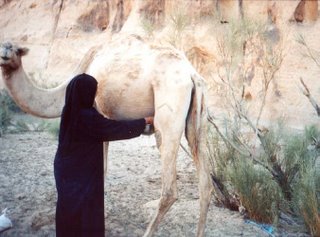UN Promoting Camel Milk
This is not a joke. Next thing you know, we'll be completely dependent on camel milk imports....19 April 2006 – Developing camel dairy products such as milk can not only provide more food to people in arid and semi-arid areas but also give nomadic herders a rich source of income, with a $10 billion world market entirely within the realm of possibility, according to the United Nations Food and Agriculture Organization (FAO).
“The potential is massive. Milk is money,” FAO’s Dairy and Meat expert Anthony Bennett said in a review of camel milk potential, noting that the agency is hoping donors and investors will come forward to develop the sector not only at the local level but helping it move into lucrative markets in the Middle East and the West.

From the Western Sahara to Mongolia demand is booming for camel milk, but there just isn’t enough to go round. State-of-the art camel rearing is rudimentary, and much of the 5.4 million tonnes of milk currently produced every year by the world population of some 20 million camels is guzzled by young camels themselves.
To devotees, camel milk is pure nectar. While slightly saltier than cows’ milk, it is three times as rich in Vitamin C as its bovine equivalent. But tapping the market involves surmounting a series of humps in production, manufacturing and marketing.
But the main challenge stems from the fact that the producers involved are, overwhelmingly, nomads, a situation similar to a tomato cannery depending on suppliers who regularly disappear, taking their tomatoes with them.
Another problem is that nomad camel herders are often reluctant to sell their spare milk, which tradition reserves for honoured guests and the poor. It has been noted, however, that such reluctance can be dispelled by the offer of a good price.
Jumping on the camel train, Vienna-based chocolatier Johann Georg Hochleitner intends to launch this autumn a low-fat, camel milk chocolate with funding from the Abu Dhabi royal family, making it in Austria from powdered milk produced at Al Ain in the United Arab Emirates, then shipping 50 tons back to the Gulf each month.
By surmounting a few production humps, camel milk could bring in billions – UN



0 Comments:
Post a Comment
<< Home